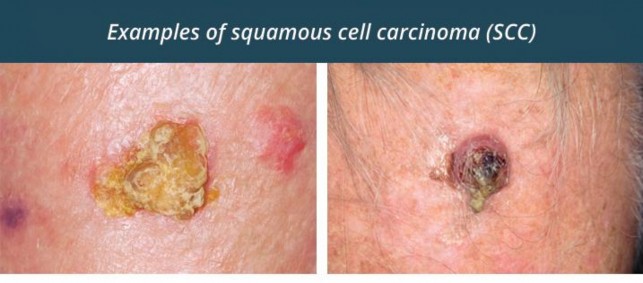Skin Cancer
What is squamous cell carcinoma?
Squamous cell carcinoma (SCC) is one of the most common forms of skin cancer. It can develop on parts of the body that get a lot of sun, such as the head, neck, face, hands and arms. Squamous cell carcinoma is not as dangerous as melanoma, but it can spread to other parts of the body if not treated. Every year, some people in Australia die from aggressive SCCs.
What are the types of squamous cell carcinoma?
Squamous cell carcinoma develops when the flat cells in the top layer of skin (called squamous cells) grow and divide in an uncontrolled way.
You can get an SCC wherever there are squamous cells — which is in many different parts of the body. However, typically they appear on parts of the skin that have been exposed to a lot of ultraviolet (UV) radiation from the sun or from tanning beds.
An early form of skin cancer, called Bowen’s disease, which looks like a red, scaly patch, can also develop into an SCC if not treated.
An SCC can be quite an aggressive cancer if left untreated. If you ever notice a sore, scab or scaly patch of skin that doesn’t heal within 2 months, see a doctor.

What are the symptoms of squamous cell carcinoma?
The first sign of an SCC is usually a thickened, red, scaly spot that doesn’t heal. You are most likely to find an SCC on the back of your hands, forearms, legs, scalp, ears or lips. If it’s on your lips, it can look like a small ulcer or patch of scaly skin that doesn’t go away.
An SCC may also look like:
- a crusted sore
- a small ulcer or thickened scaly skin on the lips
- a patch of skin that’s sore
- a firm, red lump
- a sore or rough patch inside your mouth
- a red, raised sore around your anus or genitals
An SCC will probably grow quickly over several weeks or months.
How is squamous cell carcinoma diagnosed?
If you think you might have an SCC, see your doctor. They may send you to see a dermatologist (a doctor who specialises in skin).
If you go to the dermatologist, they will examine you and may take a small sample from the sore to test in the lab. This is known as a biopsy.
How is squamous cell carcinoma treated?
It is usually possible to completely remove an SCC. The best type of treatment for you will depend on the size of the SCC and where it is.
Usually, the doctor will remove an SCC using simple skin surgery. They will then look at the area under a microscope to check all the cancer has been removed. If it has spread, you might need further treatment afterwards.
Other ways of removing the SCC are:
- scraping it off then sealing the base of the wound with an electric needle or liquid nitrogen
- using a laser to burn the SCC away
- freezing it off
- Applying creams, liquids or lotions directly onto the SCC.
After treatment, you will need follow-up appointments with your doctor. You will be at greater risk of developing another skin cancer, so it’s more important than ever to protect your skin from the sun.
Can squamous cell carcinoma be prevented?
The best way to prevent SCC is to avoid sunburn. Avoid going out in the sun when the UV Index is higher than 3, such as in the middle of the day. Seek shade, wear a hat, sunglasses and clothing that protects you from the sun, and always use an SPF30+ (or higher) sunscreen.
When to seek help
Not all sores on the skin are skin cancer. But if you do develop a skin cancer, the earlier it is treated, the better the outcome for you.
Most people find SCCs by checking their own skin. Check your skin regularly so you notice any changes. See a doctor if:
- you have a sore that doesn’t heal in 2 months
- you notice a new and unusual looking spot
- an existing spot changes in colour, size or shape
- you have a spot that is asymmetrical (irregular and not round or oval)
- you have a spot with an uneven border
- you have a spot with an unusual or uneven colour
- you have a spot that is larger than 7 mm


